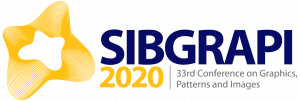Main Track
Call for Technical Paper Contributions
Original unpublished papers are invited. All manuscripts submitted to SIBGRAPI 2020 Technical Paper Track (Main Track) must be in English and must have between six (6) and eight (8) pages, to be prepared the SIBGRAPI IEEE format available below.
All full papers are to be double blindly reviewed by at least three experts in the topic of the work. The final program will only include papers with at least one author registered with full registration rate in the conference. Each paper must be associated with a different full registration. All papers included in the proceedings of the conference will be submitted to IEEE Xplore and also to the SIBGRAPI Digital Library Archive maintained by Instituto Nacional de Pesquisas Espaciais (INPE, Brazil).
Pattern Recognition Letters Special Section
SIBGRAPI 2020 announces the selection of the three Best Papers on Pattern Recognition and Related Fields from the main track. The authors of the 3 best papers will be selected and invited for the submission of an extended version for a SIBGRAPI 2020 Special Section of the Pattern Recognition Letters journal, which will be reviewed following the instructions available at https://www.journals.elsevier.com/pattern-recognition-letters/.
Extended paper submission period: February 1st – 7th 2021
Final decision: June 7th 2021
Submission Instructions
The SIBGRAPI IEEE LaTeX style is available below:
Please follow the included instructions and the IEEE formatting guidelines, avoiding any change to the format (in particular avoiding \vspace command, or creating subsections or paragraph title with any command different from \subsection or \paragraph). The bibliography should be formatted with a 9pt font. Please do not change the font size, even if it helps to comply with the page limit. The illustrations of the paper should be generated either truly vectorial or rasterized with at least 300dpi.
Authors may include up to 3 files (PDF or ZIP) under 50 MB as supplementary materials with the submission.
Paper submission will be handled via CMT system.
Anonymity Requirements
Once the review process of submissions will be double-blind, authors must prepare their manuscripts without including any indication of their identities or institutional affiliations. Author’s identities will be tracked only by the submission system, and visible only by the track chairs. The program committee members and referees who review the paper will not know the identity of the authors.
To ensure anonymity of authorship, authors must prepare their manuscript as follows:
- Funding sources must not be acknowledged anywhere in the paper.
- Authors’ names and affiliations must not appear on the title page or elsewhere in the paper. Instead, please include under the title the number assigned to your paper by the online paper registration system, for instance, by including the command \finalfalse in your LaTeX source file.
- Research group members, colleagues or other collaborators must not be acknowledged anywhere in the paper.
- It is strongly suggested that the submitted file is named with the assigned submission number. For example, if your assigned paper number is 39352, then name your submitted file 39352.pdf.
- Source file naming must also be done with care. For example, if your name is Jane Smith and you submit a PDF file generated from a .dvi file called Jane-Smith.dvi, one can infer your authorship by looking into the PDF file.
- You must also use care in referring to related past work, particularly your own. For example, avoid mention to your work as “In our previous work [1,2]…”, prefer third person referencing as “In previous work [1,2]…”. Despite the anonymity requirements, you should still include all relevant work of your own in the references, using the above style (omitting them could potentially reveal your identity by negation).
It is the responsibility of authors to do their best to preserve anonymity. Papers that do not follow the guidelines here, or otherwise potentially reveal the identity of the authors, are subject to immediate rejection.
Paper Presentation
All accepted papers are scheduled for either oral or poster presentation according to the schedule defined for the Main Track. The oral presentations must fit in 15 minutes, with an additional 5 minutes for questions. Slides and presentation must be in English. The posters must be in the portrait format and fit the A0 paper size (84.1 cm x 118.9 cm). The poster support has a hanger on its top that can be used to hang the poster.
No-Show and No-Registration Policy
No-show papers are defined as accepted papers submitted by authors who subsequently did not present the paper in-person (no videos,no remote cast) at the technical meeting. No-registration papers are defined as accepted papers where at least one author did not register with full paid registration rate (Professional SBC member or Professional non member + Publication Fee for Professional Author) for the conference, where each paper must be associated with a different full paid registration. No-show and no-registration papers will not be included in the program and will be removed from the proceedings and from the IEEE Xplore.
Program Chairs
Soraia R. Musse (PUC-RS)
Roberto M. Cesar Jr (USP)
Nuria Pelechano (Universitat Politècnica de Catalunya)
Zhangyang (Atlas) Wang (Texas A&M)
If you have any questions, please don’t hesitate to contact the program chairs.
Deadlines for Regular SIBGRAPI Papers
Submission deadline: July 3, 2020Submission deadline:July 10, 2020Submission deadline: July 17, 2020- Submission deadline: July 19, 2020 (firm)
Notification of acceptance: August 28, 2020- Notification of acceptance: September 02, 2020
Camera-ready due: September 11, 2020- Camera-ready due: September 30, 2020
Warning: Incomplete or late submissions will not be considered. All deadlines expire at 23:59 PST.

